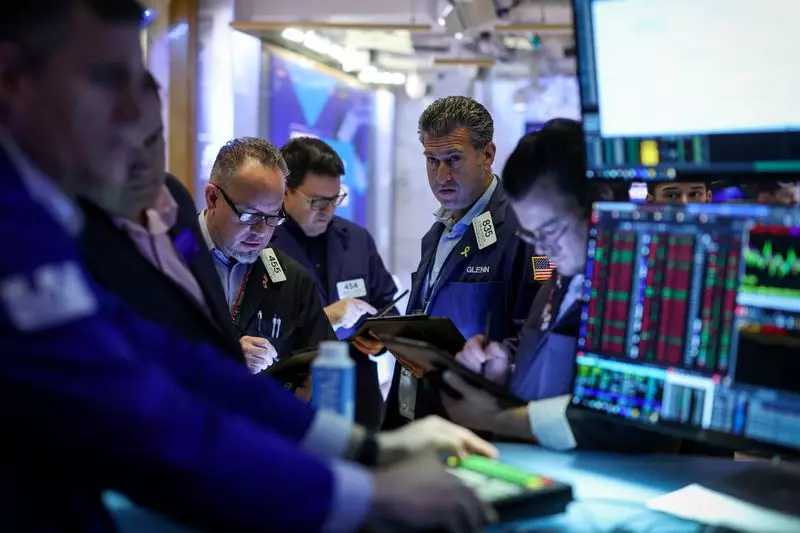The stock market is often a reflection of broader economic conditions, and recent data regarding inflation has raised significant concerns among investors. As Wall Street prepared for trading on Friday, the notable apprehension over sustained high interest rates loomed large, albeit somewhat mitigated by a surprise in the latest inflation report. The Personal Consumption Expenditure (PCE) index—considered the Federal Reserve’s go-to metric for assessing inflation—showed an annual increase of 2.4% in November, slightly lower than the 2.5% anticipated by economists. This data revealed that inflationary pressures, while still present, may not be escalating as rapidly as previously thought.
Market participants reacted to the PCE index with cautious optimism, adjusting their expectations for future Federal Reserve rate reductions. Prior to this report, traders had estimated a significant chance of a second rate cut by December 2025. However, the newfound data led the market to revise its forecasting to anticipate cuts beginning as early as March 2025, and possibly again in October. Yet, even amidst this recalibration, Wall Street remains uneasy. The Fed’s recent projection indicating only two rate cuts in 2025, alongside an upward revision of inflation estimates, has served as a reminder of the prevailing economic resilience that could belabor the decline of interest rates.
In analyzing the decisions coming from the Federal Reserve, it’s evident that the central bank is approaching future monetary policy changes with considerable caution. San Francisco Fed President Mary Daly described the recent decision-making process surrounding interest rates as a “close call,” reinforcing Fed Chair Jerome Powell’s perspective on the need for prudence in navigating forthcoming monetary policies. The pronounced concern over inflation—after weeks of relative calm—signals a shift in narrative that could well influence market performance heading into the new year.
Mike Dickson, head of research and quantitative strategies at Horizon Investments, echoed the sentiment of uncertainty permeating the market. His observation that the current balance between a healthy labor market and inflationary anxieties has shifted highlights the intricate balance the Fed must maintain. With the strong job market typically supportive of consumers and growth, inflation remains a persistent threat that requires careful monitoring.
As Wall Street grappled with these evolving dynamics, the broader market displayed signs of volatility. Initial trading forecasts indicated declines across major indexes, with the Dow E-minis down by 148 points and the S&P 500 E-minis reflecting similar losses. Notably, the Nasdaq 100 was also projected to experience its first downturn in five weeks, marking a significant pause in its recent growth streak.
In addition to concerns over interest rates and inflation, external political factors threatened to further unsettle the market landscape. The U.S. Congress found itself in a critical race against the clock to avert a partial government shutdown, which compounded anxieties as negotiations faltered amid partisan divisions. Investment strategist Paul Christopher from Wells Fargo noted the challenges in reaching a timely agreement, suggesting that while a new spending bill may emerge by year-end, the looming shutdown could destabilize the market further in the short term.
Despite the day-to-day fluctuations and looming uncertainties, analysts maintain a cautiously optimistic outlook for the stock market in the upcoming year. Projections for the S&P 500 vary considerably but generally suggest an upward trajectory, with targets ranging from 6,000 to 7,000, positioning the index comfortably above its current level of around 5,900.
Yet, prominent technology and megacap stocks faced downturns during the premarket trading period, with key players like Tesla, Nvidia, and Amazon all showing declines. Nike’s significant revenue forecast drop raised alarms, resulting in a notable plunge in its stock price. Conversely, FedEx experienced a beneficial surge following its strategic decision to spin off its freight trucking division, showcasing the potential for operational restructuring to bolster market performance. Meanwhile, Eli Lilly’s advancement in the wake of competitor struggles indicates the complex dynamics within the pharmaceutical sector.
As Wall Street navigates the tumultuous waters of inflation, interest rates, and unforeseen political hurdles, investors are left surveying a landscape rife with challenges yet imbued with potential opportunities for recovery and growth in the year ahead. The key will be maintaining a keen focus on economic indicators and corporate strategies as they unfold in real-time.

